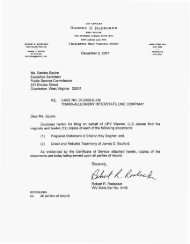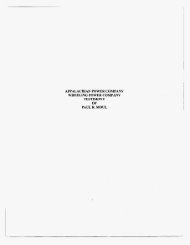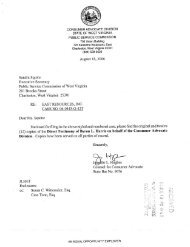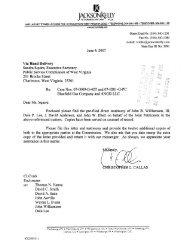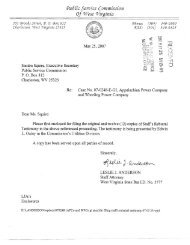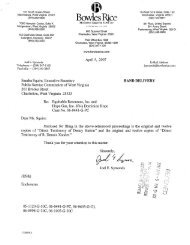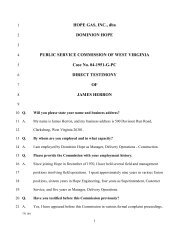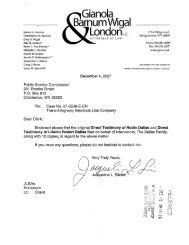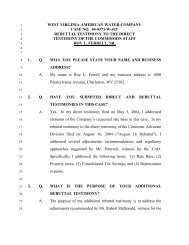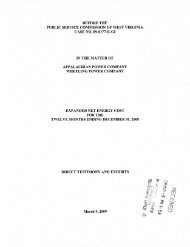Direct Testimony of Thomas M. Hildebrand - Consumer Advocate ...
Direct Testimony of Thomas M. Hildebrand - Consumer Advocate ...
Direct Testimony of Thomas M. Hildebrand - Consumer Advocate ...
You also want an ePaper? Increase the reach of your titles
YUMPU automatically turns print PDFs into web optimized ePapers that Google loves.
PjM, New York, and New England) aione couid save consumers about $500 miliio~ annu-<br />
ally. Savings could be even greater because DOE’S analysis does nor capture ail <strong>of</strong> the<br />
----<br />
factors, such as impacts on teiiability, that result from bottlenecks.<br />
_-- -\<br />
mission technologies and improved operating practices, 12,.,<br />
siting generation closer to areas where electricity is needed, and reducing electricity use<br />
through targeted energy efficiency and distributed generation could all help reduce<br />
transmission congestion.<br />
@ Better utilizing existing facilities can help delay the need for new transmission facilities,<br />
cannot avoid construction <strong>of</strong> new transmission facilities entirely.<br />
---7--<br />
’<br />
Much work is needed to address transmission bottlenecks and modernize our nation’s<br />
transmission systems. As a percentage <strong>of</strong> total energy use, electricity use is growing.2 This<br />
reflects the transformation <strong>of</strong> our economy to an increasingly sophisticated, information-based<br />
economy, one that relies on electricity. Electricity, though, is not a commodity that can be<br />
stored easily. Our transmission infrastructure is at the heart <strong>of</strong> our economic well-being.<br />
Imagine an interstate highway system without storage depots or warehouses, where traffic<br />
congestion would mean not just a loss <strong>of</strong> time in delivering a commodity, but a loss <strong>of</strong> the<br />
commodity itself. This is the nature <strong>of</strong> the transmission infrastructure. That is why bottlenecks<br />
are so important to remove and why an efficient transmission infrastructure is so important to<br />
maintain and develop.<br />
This report outlines 51 recommendations that will help ensure a robust and reliable trans-<br />
mission grid for the 21 st century. The following are six general recommendations:<br />
0 First, we must increase regulatory certainty by completing the transition to competitive<br />
regional wholesale markets.<br />
% Second, we need to develop a process for identifying and addressing national-interest<br />
transmission bottlenecks.<br />
*,><br />
‘xi,+,<br />
i<br />
. . . . . . . . . . . . . . . . . , , . , . . . . . . . . . . , , , , . . . . . . . . . . . . . .<br />
‘In 1970, eiectricity accounted for 8 percent <strong>of</strong> totai US. energy use. In 2000, electricity accounted for<br />
16 percent <strong>of</strong> total US. energy use. Source: Energy Information Administration. Annual Energy Outlook 2002.<br />
Download from http://w.eia.doe.gov



